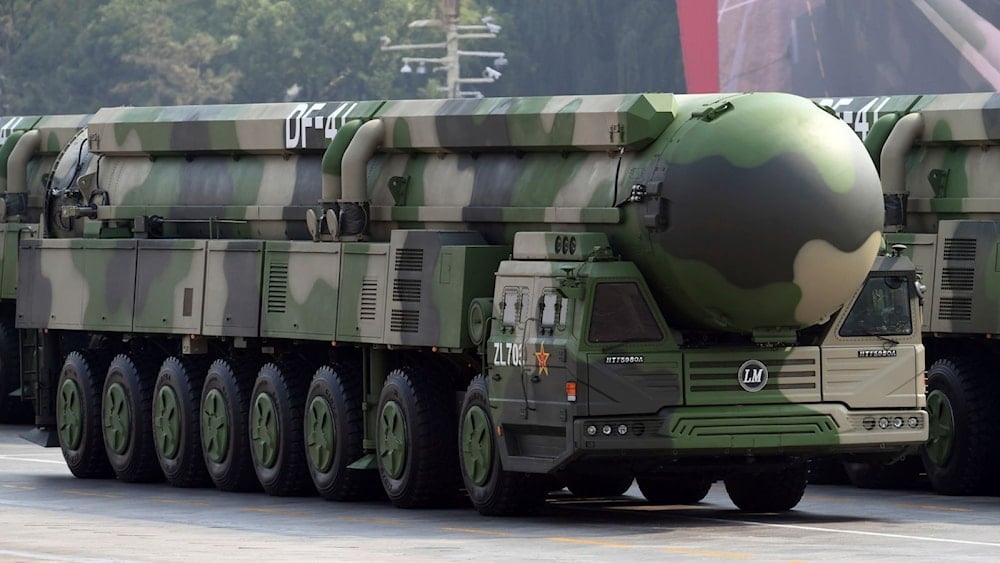China unveils first AI system for nuclear warhead verification
China has unveiled the world’s first AI-powered nuclear warhead verification system, designed to authenticate weapons without exposing classified designs.
-

A Chinese Dongfeng-41 intercontinental strategic nuclear missile (AP)
Chinese scientists have developed the world’s first artificial intelligence-powered nuclear warhead inspection system, capable of distinguishing real weapons from decoys without revealing classified design data.
The achievement, disclosed in a peer-reviewed study by researchers at the China Institute of Atomic Energy (CIAE), marks a historic leap in arms control technology, potentially reshaping global verification protocols. The system's unveiling was first reported by the South China Morning Post.
Built on a decade-old protocol proposed by both Chinese and American experts, the AI solution integrates deep learning with cryptographic techniques to verify chain-reaction capabilities while shielding engineering specifics.
Its emergence comes as international disarmament talks stall, and as AI’s role in managing weapons of mass destruction draws increasing scrutiny.
Deep learning meets zero-knowledge protocol
The core of the CIAE project, known as the “Verification Technical Scheme for Deep Learning Algorithm Based on Interactive Zero Knowledge Protocol,” uses Monte Carlo simulations and layered neural networks trained on neutron flux patterns.
These simulations generate millions of virtual nuclear components, some with weapons-grade uranium, others filled with decoy materials like lead.
By analyzing radiation data masked behind a 400-hole polyethylene wall, the AI distinguishes authentic warheads from fakes without accessing internal designs.
This system was highlighted as a scientific milestone in the exclusive South China Morning Post report. To preserve secrecy, the wall scrambles geometry while letting radiation signatures through. The AI learns to identify nuclear reactivity, the essence of a warhead, without ever seeing its configuration.
CIAE, a branch of China National Nuclear Corporation (CNNC), developed the platform with guidance from physicists who pioneered China’s miniaturized arsenal.
New system aims to rebuild trust in disarmament
The study admits that only one of three major challenges has been addressed so far: training the AI on secure datasets. Meanwhile, convincing Chinese military leadership that this system won’t leak state secrets and persuading global partners, especially the US, to replace Cold War-era verification protocols, remain unresolved hurdles.
As the South China Morning Post notes, the system sidesteps reliance on complex, trust-dependent “information barrier” hardware used by the US, UK, and Russia.
Those older tools often output simple yes/no results while handling classified data behind opaque systems.
In contrast, the Chinese AI model allows for collaborative training and sealing of software between inspection parties to prevent tampering and backdoor access.
Secrecy, security remain central challenges
The researchers emphasized that once jointly prepared, the AI code must be sealed before verification begins.
"In nuclear warhead component verification for arms control, it is critical to ensure that sensitive weapon design information is not acquired by inspectors while maintaining verification effectiveness," the paper states.
According to the South China Morning Post, this makes China’s approach potentially more scalable and transparent in theory, although still in a formative stage. The system was designed to allow verification without electronic vulnerability or third-party oversight dependency, thereby reducing risks of digital espionage.
Global concerns over AI militarization grow
The announcement arrives at a tense geopolitical moment, with US-China nuclear negotiations frozen and mutual distrust over technology governance running deep.
Beijing has long argued that traditional verification frameworks disadvantage smaller arsenals like China’s estimated 600 warheads, compared to America's nearly 3,800.
Both countries, according to SCMP, have agreed to bar AI from nuclear launch protocols. However, concerns over automated defense networks such as the proposed “Golden Dome” in the US, which would integrate AI to control autonomous weapons and accelerate response times, continue to grow.
Analysts warn that while this AI verification system represents progress in diplomacy, it also exemplifies the double-edged nature of artificial intelligence in modern warfare.

 4 Min Read
4 Min Read










